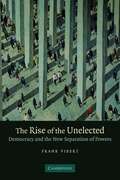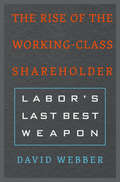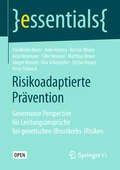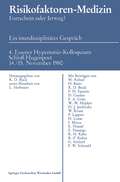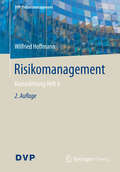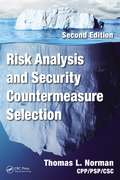- Table View
- List View
The Rise of the Roman Jurists: Studies in Cicero's "Pro Caecina"
by Bruce W. FrierCombining historical, sociological, and legal expertise, Bruce Frier discloses the reasons for the emergence of law as a professional discipline in the later Roman Republic.Originally published in 1985.The Princeton Legacy Library uses the latest print-on-demand technology to again make available previously out-of-print books from the distinguished backlist of Princeton University Press. These editions preserve the original texts of these important books while presenting them in durable paperback and hardcover editions. The goal of the Princeton Legacy Library is to vastly increase access to the rich scholarly heritage found in the thousands of books published by Princeton University Press since its founding in 1905.
The Rise of the Uncorporation
by Larry E. RibsteinThe Rise of the Uncorporation covers the history, law, and finance of unincorporated firms. These "uncorporations" including general and limited partnerships and limited liability companies, are now the dominant business form of non-publicly-traded firms. Through private equity and publicly traded partnerships, uncorporations have emerged as a significant force in the governance of a wide range of the biggest firms. This is the first general theoretical and practical overview of alternatives to incorporation, including ancillary concepts connected with the evolution of these firms, and analysis of likely future trends in business organization. The Rise of the Uncorporation provides a clear and easily understandable theoretical and practical background to this important subject.
The Rise of the Unelected: Democracy and the New Separation of Powers (PDF)
by Frank VibertUnelected bodies, such as independent central banks, economic regulators, risk managers and auditors have become a worldwide phenomenon. Democracies are increasingly turning to them to demarcate boundaries between the market and the state, to resolve conflicts of interest and to allocate resources, even in sensitive ethical areas such as those involving privacy or biotechnology. This book examines the challenge that unelected bodies present to democracy and argues that, taken together, such bodies should be viewed as a new branch of government with their own sources of legitimacy and held to account through a new separation of powers. Vibert suggests that such bodies help promote a more informed citizenry because they provide a more trustworthy and reliable source of information for decisions. This book will be of interest to specialists and general readers with an interest in modern democracy as well as policy makers, think tanks and journalists.
The Rise of the Working-Class Shareholder: Labor’s Last Best Weapon
by David WebberWhen Steven Burd, CEO of the supermarket chain Safeway, cut wages and benefits, starting a five-month strike by 59,000 unionized workers, he was confident he would win. But where traditional labor action failed, a novel approach was more successful. With the aid of the California Public Employees’ Retirement System, a $300 billion pension fund, workers led a shareholder revolt that unseated three of Burd’s boardroom allies. In The Rise of the Working-Class Shareholder: Labor's Last Best Weapon, David Webber uses cases such as Safeway’s to shine a light on labor’s most potent remaining weapon: its multitrillion-dollar pension funds. Outmaneuvered at the bargaining table and under constant assault in Washington, state houses, and the courts, worker organizations are beginning to exercise muscle through markets. Shareholder activism has been used to divest from anti-labor companies, gun makers, and tobacco; diversify corporate boards; support Occupy Wall Street; force global warming onto the corporate agenda; create jobs; and challenge outlandish CEO pay. Webber argues that workers have found in labor’s capital a potent strategy against their exploiters. He explains the tactic’s surmountable difficulties even as he cautions that corporate interests are already working to deny labor’s access to this powerful and underused tool. The Rise of the Working-Class Shareholder is a rare good-news story for American workers, an opportunity hiding in plain sight. Combining legal rigor with inspiring narratives of labor victory, Webber shows how workers can wield their own capital to reclaim their strength.
The Rise of the Working-Class Shareholder: Labor’s Last Best Weapon
by David WebberWhen Steven Burd, CEO of the supermarket chain Safeway, cut wages and benefits, starting a five-month strike by 59,000 unionized workers, he was confident he would win. But where traditional labor action failed, a novel approach was more successful. With the aid of the California Public Employees’ Retirement System, a $300 billion pension fund, workers led a shareholder revolt that unseated three of Burd’s boardroom allies. In The Rise of the Working-Class Shareholder: Labor's Last Best Weapon, David Webber uses cases such as Safeway’s to shine a light on labor’s most potent remaining weapon: its multitrillion-dollar pension funds. Outmaneuvered at the bargaining table and under constant assault in Washington, state houses, and the courts, worker organizations are beginning to exercise muscle through markets. Shareholder activism has been used to divest from anti-labor companies, gun makers, and tobacco; diversify corporate boards; support Occupy Wall Street; force global warming onto the corporate agenda; create jobs; and challenge outlandish CEO pay. Webber argues that workers have found in labor’s capital a potent strategy against their exploiters. He explains the tactic’s surmountable difficulties even as he cautions that corporate interests are already working to deny labor’s access to this powerful and underused tool. The Rise of the Working-Class Shareholder is a rare good-news story for American workers, an opportunity hiding in plain sight. Combining legal rigor with inspiring narratives of labor victory, Webber shows how workers can wield their own capital to reclaim their strength.
Risiken im Bauvertrag: Verteilung und Verlagerung
by Thomas Ax Patrick Amsberg Matthias SchneiderDer Sinn eines Vertrages liegt darin begründet, für jede Partei individuelle Risiken zu definieren und sie daran festzuhalten. In der Baupraxis tritt der Wille häufig hinter die Bestimmung des Vertragsinhaltes durch das Verkehrsübliche zurück, da die Zuordnung der Vertragsrisiken zum großen Teil vom Gesetz selbst vorgenommen ist. Im Bauvertrag, der eine Unterform des Werkvertrages darstellt, findet z. B. als Allgemeine Geschäftsbedingung die VOB/B Anwendung. Die Autoren beschreiben ausführlich die Risikotragung und Risikoverlagerung beim Werkvertrag und VOB-Vertrag nach der neuen VOB 2002. Eine Entscheidungsübersicht von über 1000 Urteilen auf der CD-ROM gibt einen schnellen Zugriff auf die aktuelle Rechtsprechung.
Risiko Aufklärung: Schmerzensgeld trotz Behandlungserfolg - Wohin führt die Rechtsprechung? (MedR Schriftenreihe Medizinrecht)
by K. O. Bergmann T. Ratajczak C. M. Stegers W. Gaus R. Jungbecker H. F. Kienzle R. T. Müller H. SchünemannDie Entwicklung des Rechts der Risikoaufklärung spaltet die im Medizinrecht tätigen Anwälte ebenso wie die Ärzteschaft in Lager. Beklagt wird einerseits eine nach wie vor ungenügende Bereitschaft der Ärzte, Patienten über die mit medizinischer Behandlung verbundenen Risiken und Gefahren aufzuklären. Beklagt wird andererseits eine ausgeuferte Rechtsprechung, die im Bereich der Medizin noch Risiken für aufklärungspflichtig halte, die weit unterhalb der Schwelle von jedermann allgemein in Kauf genommener Risiken liege. Die Beiträge liefern neben einer Analyse der bisherigen Rechtsentwicklung Anregungen für die Rechtsanwendung und Rechtsfortbildung.
Risiko-Management in Kommunen: Handlungsorientierter Leitfaden für die kommunale Praxis (Edition Innovative Verwaltung)
by Dieter HahnPraxisnaher und handlungsorientierter Leitfaden für das Risikomanagement in KommunenRisikomanagement für die Bereiche Personal, IT und Datenschutz, Beteiligungen, Projekte etc.Aus der kommunalen Praxis für die kommunale PraxisDieses Buch bietet einen pragmatischen Einstieg in ein systematisches Risikomanagement für Kommunen. Im Fokus stehen geeignete Werkzeuge, die sich auch in kleineren Verwaltungseinheiten problemlos umsetzen lassen. Der Autor arbeitet die wichtigsten Risiken im kommunalen Umfeld heraus und ordnet ihnen mögliche Steuerungsmaßnahmen zu. So erhält der Praktiker ein Nachschlagewerk, mit dem er die Bausteine für ein funktionierendes Risikomanagement in seinem Tätigkeitsbereich aufbauen kann. Die Einführung eines Risikomanagements ist in vielen Fällen damit keine Herkulesaufgabe mehr. Schon kleine, aber gut durchdachte und im Buch vorgestellte Maßnahmen, können sich so zu einem gut funktionierenden Risikomanagement aufsummieren.Das Buch ist ein leicht zu lesender Praxisleitfaden für das Risikomanagement in Gemeinden, der für einzelne Risikobereiche konkrete Maßnahmen liefert und die notwendigen Grundschritte benennt. Aus dem InhaltRahmenbedingungen für ein gelungenes Risikomanagement in KommunenZielorientierte Anwendung der Instrumente im kommunalen KontextDer RisikomanagementprozessDas Risikomanagement für die Bereiche Personal, IT und Datenschutz, Beteiligungen, Projekte, sog. dolose Handlungen sowie politische RisikenIdentifikation erster Leuchtturmprojekte für erste, schnelle ErfolgeHandlungsleitfaden: Rüstzeug für den kommunalen Alltag
Risiko-Management in Kommunen: Handlungsorientierter Leitfaden für die kommunale Praxis (Edition Innovative Verwaltung)
by Dieter HahnDieses Buch bietet einen pragmatischen Einstieg in ein systematisches Risikomanagement für Kommunen. Im Fokus stehen geeignete Werkzeuge, die sich auch in kleineren Verwaltungseinheiten problemlos umsetzen lassen. Der Autor arbeitet die wichtigsten Risiken im kommunalen Umfeld heraus und ordnet ihnen mögliche Steuerungsmaßnahmen zu. So erhält der Praktiker ein Nachschlagewerk, mit dem er die Bausteine für ein funktionierendes Risikomanagement in seinem Tätigkeitsbereich aufbauen kann. Die Einführung eines Risikomanagements ist in vielen Fällen damit keine Herkulesaufgabe mehr. Schon kleine, aber gut durchdachte und im Buch vorgestellte Maßnahmen, können sich so zu einem gut funktionierenden Risikomanagement aufsummieren.Die 2. Auflage ergänzt das vorhandene Instrumentarium um die Bow-Tie-Analyse, die die inhaltliche Verknüpfung von Ursachen und Folgen eines Risikoereignisses ermöglicht. Zudem werden relevante Zinsänderungsrisiken genauer betrachtet, da sich die „Zeitenwende“ auch in der Geldpolitik der Zentralbanken vollzieht.Das Buch ist ein leicht zu lesender Praxisleitfaden für das Risikomanagement in Gemeinden, der für einzelne Risikobereiche konkrete Maßnahmen liefert und die notwendigen Grundschritte benennt. Aus dem InhaltRahmenbedingungen für ein gelungenes Risikomanagement in KommunenZielorientierte Anwendung der Instrumente im kommunalen KontextDer RisikomanagementprozessDas Risikomanagement für die Bereiche Finanzen, Personal, IT und Datenschutz, Beteiligungen, Projekte, sog. dolose Handlungen sowie politische RisikenIdentifikation erster Leuchtturmprojekte für erste, schnelle ErfolgeHandlungsleitfaden: Rüstzeug für den kommunalen Alltag
Risiko und Verantwortung in der modernen Gesellschaft (Schriften der Mathematisch-naturwissenschaftlichen Klasse #26)
by Hermann H. Hahn Thomas W. Holstein Silke LeopoldIn der modernen Gesellschaft sind Entscheidungen, z.B. zur Umweltvorsorge für den Wassersektor, durch einerseits wachsende Risiken, andererseits diffuser werdende Verantwortlichkeiten geprägt. Die Beiträge stammen aus einer Reihe von Akademiesitzungen; sie beginnen mit einer philosophischen Begründung für die außerordentliche Rolle, die ‚alles Wasser in unserem Leben‘ spielt. Risiken für den Bereich der umwelt- und gesundheitsrelevanten Kompartimente Atmosphäre und Wasser zu identifizieren, zu quantifizieren und den Betroffenen zu kommunizieren, ist neben deren naturwissenschaftlichen Komponenten auch eine Herausforderung für die Politikwissenschaft. Risiko ist dabei zu verstehen als der Versuch, die Folgen menschlichen Handelns möglichst quantitativ und auch im Hinblick auf die Wahrscheinlichkeit des Eintretens vorherzusagen. Neben der Erörterung der Risikoaspekte in der Setzung von Qualitätsstandards im Umwelt- und Verbraucherbereich ist vor allem die Verantwortbarkeit angesprochen.
Risikoadaptierte Prävention: Governance Perspective für Leistungsansprüche bei genetischen (Brustkrebs-)Risiken (essentials)
by Friedhelm Meier Anke Harney Kerstin Rhiem Anja Neumann Silke Neusser Matthias Braun Jürgen Wasem Rita Schmutzler Stefan Huster Peter DabrockDie vorliegende Studie empfiehlt, Leistungsansprüche für Personen mit interventionsfordernden (Brustkrebs-)Risiken anhand einer neuen Rechtskategorie, der ‚risikoadaptieren Prävention‘, abzubilden. Spätestens seit dem bioinformatischen Innovationsschub (Big Data) kann eine risikoadaptierte Anwendung von prophylaktischen Maßnahmen umfassend gewährleistet werden. Jedoch können die gegebenen Rechtskategorien (primäre Prävention, Vorsorge, Krankenbehandlung) das medizinische Anwendungsfeld nicht adäquat steuern.Die Autoren Friedhelm Meier, Anke Harney, Kerstin Rhiem, Anja Neumann, Silke Neusser, Matthias Braun, Jürgen Wasem, Rita Schmutzler, Stefan Huster und Peter Dabrock haben zusammen im BMBF geförderten Projekt SYSKON. Re-Konfiguration von Gesundheit und Krankheit. Ethische, psychosoziale, rechtliche und gesundheitsökonomische Herausforderungen der Systemmedizin die vorliegende Governance Perspective erarbeitet.
Risikobeteiligung und Verantwortung als notwendige Machtkorrektive: Nachdenkliches zum Gesellschaftsrecht sowie zu Banken- und Umweltkrisen (essentials)
by Wolfgang MarotzkeIn diesem essential werden Asymmetrien von Herrschaft und Risikobeteiligung näher beleuchtet und bewertet. Der Autor Wolfgang Marotzke befasst sich mit grundlegenden gesellschaftsrechtlichen Fragen, mit den Ursachen von Banken- und Finanzmarktkrisen sowie mit der Eingehung von Umweltrisiken zulasten künftiger Generationen. Das Buch gibt eine Fülle von Denkanstößen zu Schlüsselfragen unserer Gesellschaft und erörtert die Möglichkeiten des Rechtssystems, steuernd einzugreifen.
Risikomanagement: Kurzanleitung Heft 4 (DVP Projektmanagement)
by Wilfried HoffmannDas Buch erläutert übersichtlich, was sich hinter dem Begriff "Risikomanagement" verbirgt. Es liefert zudem Handlungsempfehlungen und -anleitungen. Bauprojekte werden von unterschiedlichen Risiken begleitet, die sich auf die gesteckten Ziele auswirken können. Um die zu Projektbeginn definierten Ziele am Ende des Projekts auch wirklich zu erreichen, sind regelmäßig Entscheidungen zu treffen. Eine zielführende Entscheidung kann jedoch nur dann mit großer Sicherheit getroffen werden, wenn alle Abhängigkeiten bekannt sind. Sind den Projektbeteiligten diese Abhängigkeiten unbekannt, bestehen Unsicherheiten, die sich aus einem Anteil Ungewissheit (Wagnis) und einem Anteil Risiken zusammensetzen. Die Risiken lassen sich je nach Ausprägung als Gefahren (negative Zielerreichung) oder aber als Chancen (positive Zielabweichung) darstellen. Ein im Projekt etabliertes Risikomanagement hilft, die immanenten Risiken maßgeblich zu minimieren. Es kann die negativen Abweichungen in den Projektprozessen optimieren und einen Mittelweg zwischen Gefahren und Chancen austarieren.
Risikomanagement in Verbänden: Module einer risikobewussten Verbandsführung (NPO-Management)
by Astrid HeilmairAstrid Heilmair entwickelt eine theoretische, empirisch fundierte und zugleich praxisorientierte Vorgehensweise, die Verbände bei der Etablierung und operativen Umsetzung eines Risikomanagements unterstützt.
Rising from the Mailroom to the Boardroom: Unique Insights for Governance, Risk, Compliance and Audit Leaders (Internal Audit and IT Audit)
by Bruce R. TurnerBoards and business leaders expect their key advisors to deliver fresh insights, and increasingly expect them to demonstrate foresight. To achieve what is expected, it is crucial to understand the dynamics of conversations in the boardroom and around the audit committee table. This book provides those unique perspectives. The journey from the ‘mailroom to the boardroom’ follows the story of a young banker who moved into the internal auditing profession as part of the ‘new breed’, then rose through the ranks into senior leadership and chief audit executive roles, before assuming audit committee and board roles that had an immense influence on governance, risk, compliance, and audit professionals. Success does not always follow a smooth and uneventful trajectory, and this story reflects insights from both the ups and the downs of the journey. Each chapter shares insights, better practices, case studies, practical examples, and real-life challenges and draws them together into 101 building blocks, each one providing crucial career-long learnings. The storytelling provides insights to people at all levels on the importance of positioning oneself to step into leadership roles, helps them understand how to evaluate and pursue potential career growth opportunities, provides tips on how to holistically manage and advance their career, and inspires higher-level thinking that enhances governance, risk, compliance and audit practices.
Rising from the Mailroom to the Boardroom: Unique Insights for Governance, Risk, Compliance and Audit Leaders (Internal Audit and IT Audit)
by Bruce R. TurnerBoards and business leaders expect their key advisors to deliver fresh insights, and increasingly expect them to demonstrate foresight. To achieve what is expected, it is crucial to understand the dynamics of conversations in the boardroom and around the audit committee table. This book provides those unique perspectives. The journey from the ‘mailroom to the boardroom’ follows the story of a young banker who moved into the internal auditing profession as part of the ‘new breed’, then rose through the ranks into senior leadership and chief audit executive roles, before assuming audit committee and board roles that had an immense influence on governance, risk, compliance, and audit professionals. Success does not always follow a smooth and uneventful trajectory, and this story reflects insights from both the ups and the downs of the journey. Each chapter shares insights, better practices, case studies, practical examples, and real-life challenges and draws them together into 101 building blocks, each one providing crucial career-long learnings. The storytelling provides insights to people at all levels on the importance of positioning oneself to step into leadership roles, helps them understand how to evaluate and pursue potential career growth opportunities, provides tips on how to holistically manage and advance their career, and inspires higher-level thinking that enhances governance, risk, compliance and audit practices.
Rising Road: A True Tale of Love, Race, and Religion in America
by Sharon DaviesIt was among the most notorious criminal cases of its day. On August 11, 1921, in Birmingham, Alabama, a Methodist minister named Edwin Stephenson shot and killed a Catholic priest, James Coyle, in broad daylight and in front of numerous witnesses. The killer's motive? The priest had married Stephenson's eighteen-year-old daughter Ruth to Pedro Gussman, a Puerto Rican migrant and practicing Catholic. Sharon Davies's Rising Road resurrects the murder of Father Coyle and the trial of his killer. As Davies reveals with novelistic richness, Stephenson's crime laid bare the most potent bigotries of the age: a hatred not only of blacks, but of Catholics and "foreigners" as well. In one of the case's most unexpected turns, the minister hired future U.S. Supreme Court Justice Hugo Black to lead his defense. Though regarded later in life as a civil rights champion, in 1921 Black was just months away from donning the robes of the Ku Klux Klan, the secret order that financed Stephenson's defense. Entering a plea of temporary insanity, Black defended the minister on claims that the Catholics had robbed Ruth away from her true Protestant faith, and that her Puerto Rican husband was actually black. Placing the story in social and historical context, Davies brings this heinous crime and its aftermath back to life, in a brilliant and engrossing examination of the wages of prejudice and a trial that shook the nation at the height of Jim Crow. "Davies takes us deep into the dark heart of the Jim Crow South, where she uncovers a searing story of love, faith, bigotry and violence. Rising Road is a history so powerful, so compelling it stays with you long after you've finished its final page." --Kevin Boyle, author of the National Book Award-winning Arc of Justice "This gripping history...has all the makings of a Hollywood movie. Drama aside, Rising Road also happens to be a fine work of history." --History News Network
Rising Road: A True Tale of Love, Race, and Religion in America
by Sharon DaviesIt was among the most notorious criminal cases of its day. On August 11, 1921, in Birmingham, Alabama, a Methodist minister named Edwin Stephenson shot and killed a Catholic priest, James Coyle, in broad daylight and in front of numerous witnesses. The killer's motive? The priest had married Stephenson's eighteen-year-old daughter Ruth to Pedro Gussman, a Puerto Rican migrant and practicing Catholic. Sharon Davies's Rising Road resurrects the murder of Father Coyle and the trial of his killer. As Davies reveals with novelistic richness, Stephenson's crime laid bare the most potent bigotries of the age: a hatred not only of blacks, but of Catholics and "foreigners" as well. In one of the case's most unexpected turns, the minister hired future U.S. Supreme Court Justice Hugo Black to lead his defense. Though regarded later in life as a civil rights champion, in 1921 Black was just months away from donning the robes of the Ku Klux Klan, the secret order that financed Stephenson's defense. Entering a plea of temporary insanity, Black defended the minister on claims that the Catholics had robbed Ruth away from her true Protestant faith, and that her Puerto Rican husband was actually black. Placing the story in social and historical context, Davies brings this heinous crime and its aftermath back to life, in a brilliant and engrossing examination of the wages of prejudice and a trial that shook the nation at the height of Jim Crow. "Davies takes us deep into the dark heart of the Jim Crow South, where she uncovers a searing story of love, faith, bigotry and violence. Rising Road is a history so powerful, so compelling it stays with you long after you've finished its final page." --Kevin Boyle, author of the National Book Award-winning Arc of Justice "This gripping history...has all the makings of a Hollywood movie. Drama aside, Rising Road also happens to be a fine work of history." --History News Network
Rising Tides (Mills And Boon M&b Ser.)
by Emilie RichardsNine people have gathered for the reading of Aurore Gerritsen's will. Some are family, others are strangers. But all will have their futures changed forever when a lifetime of secrets is finally revealed.
Risk: The Concepts of Risk, Danger and Chance (PDF)
by Ben AleInvestments, global warming and crossing the road – risk is a factor embedded in our everyday lives but do we really understand what it means, how it is quantified and how decisions are made? In six chapters Ben Ale explains the concepts, methods and procedures for risk analysis and in doing so provides an introductory understanding of risk perception, assessment and management. Aided by over seventy illustrations, the author casts light on the often overlooked basics of this fascinating field, making this an essential text for students at undergraduate and postgraduate level as well as policy and decision-making professionals. Developed from the Safety Science or Risk Science course taught at Delft University, this highly respected author has a lifetime of knowledge and experience in the study of risk.
Risk: A Novel
by Colin HarrisonGeorge Young, a world-weary insurance lawyer in New York City, has taken his fair share of knocks and bruises in the business of credit, bankruptcy, and fraud cases. One Friday he receives an unusual request from the elderly and ailing widow of Wilson Corbett, the founder of the firm George has worked for all his life. At first it seems one more unwanted call on his time, but loyalty to his former boss won't let him ignore it, for the elderly Mrs Corbett has recently lost her son and she wants the truth about his fatal accident.A former high-flier, Roger Corbett's career - and marriage - had fallen apart in the credit crunch, costing him millions. But what was written on the piece of paper which distracted him seconds before he was run down by a garbage truck outside a New York bar? Roger's new girlfriend, a mysterious Czech model with dubious Russian connections, knows more about his last moments than she's letting on, everyone is warning him off, while Mrs Corbett's reasons for choosing George for this last personal favour remain frustratingly unclear...
Risk Analysis and Governance in EU Policy Making and Regulation: An Introductory Guide
by Bernardo DeloguThis book provides an easy, but comprehensive and rigorous access to the main concepts, terminology, methods and procedures of risk analysis intended for all those involved in the EU policy and regulatory decision making on risks. It establishes a common ground of knowledge which enables a more informed dialogue on risks, a closer collaboration between decision makers and scientists and a better appraisal of the potential and limits of risk science. The book also brings together in an accessible way much multidisciplinary knowledge which had been dispersed over many technical documents and specialist books.The EU is in the front line of health, safety and environmental risk management. GMOs, food safety, hazardous chemicals, climate change, radiation hazards, are just a few of the popular risk issues addressed by the EU through policy and regulatory measures. The risk analysis paradigm, including risk assessment, management and communication has been at the core of the EU decision making for a long time already. EU Institutions strive for a science-based approach to risk management. Nevertheless, the dialogue and collaboration on risk issues between policy makers, stakeholders and scientists are still difficult and the potential and limits of science in support of decision making, as well as the basic concepts of risk analysis are not fully understood outside the narrow specialist circles.
Risk Analysis and Security Countermeasure Selection
by Thomas L. Norman CPP/PSP/CSCThis new edition of Risk Analysis and Security Countermeasure Selection presents updated case studies and introduces existing and new methodologies and technologies for addressing existing and future threats. It covers risk analysis methodologies approved by the U.S. Department of Homeland Security and shows how to apply them to other organizations
Risk Analysis and Security Countermeasure Selection
by Thomas L. Norman CPP/PSP/CSCThis new edition of Risk Analysis and Security Countermeasure Selection presents updated case studies and introduces existing and new methodologies and technologies for addressing existing and future threats. It covers risk analysis methodologies approved by the U.S. Department of Homeland Security and shows how to apply them to other organizations


